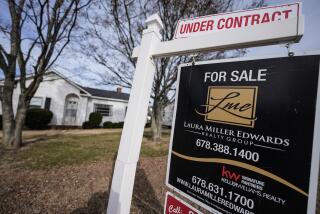Seller concession rules for FHA mortgages to be changed
- Share via
Reporting from Washington — — One of the key attractions of FHA home mortgage financing is going, going, but not quite gone. Sellers and buyers who move fast can still make the most of it.
Sometime this summer, the Federal Housing Administration plans to slash maximum “seller concessions” from 6% of the home price to 3%. Seller concession rules allow buyers to look to the property seller to pay for a variety of services and taxes connected with the transaction — loan origination and local transfer fees, appraisals, inspections, closing and escrow costs among others — though not the down payment.
Say you’re buying a $200,000 house. If you are using FHA financing under current rules, you can structure the contract so that the seller agrees to pay all closing costs and even some repairs the house needs at closing, up to 6% of the price or $12,000. On a $400,000 house, allowable concessions go to $24,000. That’s huge, especially if you have to struggle to come up with a 3.5% down payment and you’re not sure where you’ll find the closing and repair money.
Contrast that with using Fannie Mae or Freddie Mac conventional financing, where seller concessions generally are limited to 3%. For many buyers, the extra negotiating flexibility built into the FHA program makes the choice between programs a no-brainer.
When FHA officials announced the policy change this year, they said the long-standing 6% maximum “exposes the FHA to excess risk by creating incentives to inflate appraised value.” That would occur when sellers agree to pay buyers’ closing and other expenses but merely tack those costs onto the final sale price of the house. Rather than agreeing to a $200,000 price as in the example above, with $12,000 worth of concessions, the final contract price of the house would instead be $212,000.
If an appraiser did not detect and report the price boost, the FHA would effectively be insuring a mortgage on a house worth less than the sales price. In fact, since the rules allowed a 6% seller concession and the down payment was just 3.5%, the FHA would be insuring an underwater loan from the start.
To limit further possible losses, FHA decided to cut the concessions limit in half. In its announcement, the agency said the change would occur in “early summer” after publication of a Federal Register notice and a public comment period. But Lemar C. Wooley, an FHA spokesman, confirmed May 19 that there had been no Federal Register announcement.
Since public comment periods frequently run for 60 days, followed by a review period, it appears that any start date for the concessions change has slipped to late summer at the earliest. Wooley said in an e-mail that “early summer may be stretching it, but I’m told that we do still expect it this summer.”
Why does the timing matter? Whatever you might think of the FHA’s existing seller concession rules, the fact remains: Concessions of 6% are still allowed, and will be until the FHA announces that they’re not. Buyers and sellers who have a legitimate need to build concessions into their contracts can still do so, but they need to know that the clock is ticking.
Smart real estate agents and mortgage loan officers already are putting out the word: If a home sale deal needs the 6% FHA feature, get the contract put together as fast as possible. Abbie Higashi, national designated broker for ZipRealty Inc. of Emeryville, Calif., said she fully understood and supported the FHA move, but agents should “do the deals now” if more than 3% concessions would help the sale go through.
Paul Skeens, president of Colonial Mortgage Group in Waldorf, Md., said he was advising loan applicants to request a good-faith estimate upfront that provides for the seller to pay 100% of closing costs and prepaid fees “so that in cases where the buyer doesn’t have much more than the down payment, that’s the only cash they’ll need to close” on an FHA loan before the policy change.
Skeens said he’d prefer that the FHA adopt a “sliding scale” approach to concessions, with higher concessions allowed on lower-priced homes, and the lowest concessions allowed on high-priced properties. Since closing and loan expenses generally represent a larger percentage of the total transaction on lower-priced houses, he believes that the new 3% rule across the board “will have a much heavier impact on the people FHA traditionally has served,” who are buying modestly priced houses and have limited cash resources.
kenharney@)earthlink.net
Distributed by Washington Post Writers Group.
More to Read
Inside the business of entertainment
The Wide Shot brings you news, analysis and insights on everything from streaming wars to production — and what it all means for the future.
You may occasionally receive promotional content from the Los Angeles Times.










